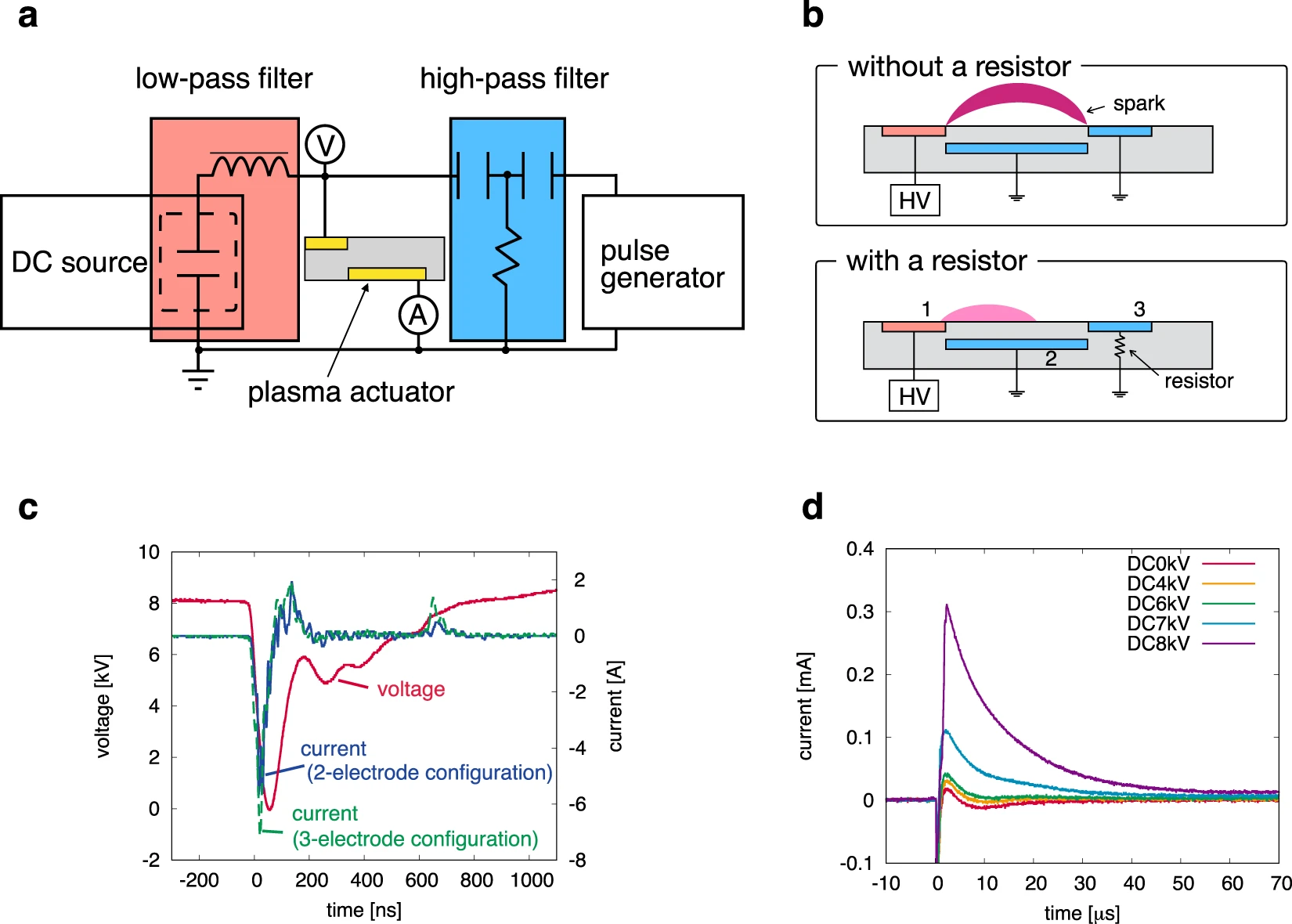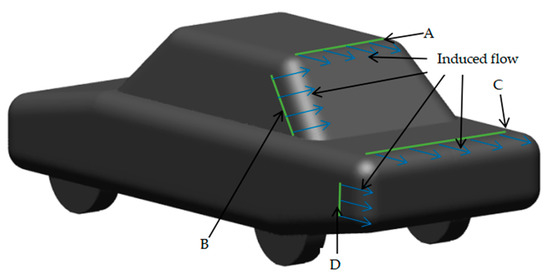 11-07-2024, 04:41 AM
11-07-2024, 04:41 AM
|
#21 (permalink)
|
|
Master EcoModder
Join Date: Aug 2022
Location: South Africa
Posts: 800
Thanks: 321
Thanked 328 Times in 287 Posts
|
DBD for attached flow on a car's rear:
See an orange line: that is a plasma actuator one would place at the beginning of a shallow boat tail.
One too shallow or short to keep flow attached under normal circumstances.
NB the power required for this stuff from the previous post.
|
|
|

|
 Today Today
|
|
|
|
 Other popular topics in this forum...
Other popular topics in this forum...
|
|
|
|
 11-07-2024, 04:59 AM
11-07-2024, 04:59 AM
|
#22 (permalink)
|
|
Master EcoModder
Join Date: Aug 2022
Location: South Africa
Posts: 800
Thanks: 321
Thanked 328 Times in 287 Posts
|
Hmmm... that looks like to open end of a Bell Mouth or Velocity stack: 
|
|
|

|
 11-07-2024, 10:51 AM
11-07-2024, 10:51 AM
|
#23 (permalink)
|
|
Master EcoModder
Join Date: Jan 2008
Location: Sanger,Texas,U.S.A.
Posts: 16,489
Thanks: 24,515
Thanked 7,436 Times in 4,817 Posts
|
' Rn '
Quote:
Originally Posted by Logic

NB how the air is NOT staying laminar over this stalled wing at a high angle of attack.
Then tell me how it's simply NOT going to keep flow attached on a short/er boat tail because I don't have Reynolds' number! 
Lets NB that an electron traveling at around 175 000km/h (IIRC) does not stop until it's inside the 2nd surface.
Any air molecule that may have been ionized by said electrons may well be traveling a lot slower, but also does not stop until IT is the molecule on the opposite charged surface.
ie: Airspeed is of little importance here and Boundary Layer is no longer part of the equation!
For anyone else who doesn't give a buck afout Renaults or his nucking fumber after seeing that,
See B here for how you do DBD:

in this paper here:
https://www.nature.com/articles/s41598-019-42284-w
Here are all the high voltage doodats you might require:
https://ioninjection.ponderworthy.com/articles/parts
|
1) Pick a useful 'size' for your wing.
2) From it's 'length', reverse-engineer it's required velocity in standard air, based upon the given stated Rn.
3) Then explain to the global community how they could derive any possible benefit in the 'real world ' from the 'so-called' technology, when applied to automobiles operating at common posted speed limits.
( the big clue is, the difference between a laminar, and turbulent boundary layer )
__________________
Photobucket album: http://s1271.photobucket.com/albums/jj622/aerohead2/
|
|
|

|
 11-08-2024, 03:13 AM
11-08-2024, 03:13 AM
|
#24 (permalink)
|
|
Master EcoModder
Join Date: Aug 2022
Location: South Africa
Posts: 800
Thanks: 321
Thanked 328 Times in 287 Posts
|
Aerodynamic Drag Reduction and Optimization of MIRA Model Based on Plasma Actuator
"...Specifically, drag reduction is better when the actuation is applied at four positions simultaneously. The maximum drag reduction coefficient of the car is reduced by 13.17%..."
... This suggests that the plasma jet can obviously inhibit the flow separation in the tail of the vehicle and strengthen the aerodynamic characteristics of the vehicle
 https://www.mdpi.com/2076-0825/9/3/64
Dielectric barrier discharge actuator for vehicle drag reduction at highway speeds
https://www.mdpi.com/2076-0825/9/3/64
Dielectric barrier discharge actuator for vehicle drag reduction at highway speeds
We propose and demonstrate reduction of aerodynamic drag for a realistic geometry
at highway speeds ... the measured drag reduced by over 14% at 26.8 m/s (60 mph) and over 10% at 31.3 m/s (70 mph) opening up realistic possibility of reasonable energy savings for full scale ground vehicles.
In addition, the power consumption data and drag reduction effectiveness for different input signals are also presented...
...Additionally, we also showed that the actuator can save 2.7 % total
drag average per watt power consumed with AM input signal and save 2.1% total drag average per watt with continuous input signal..."
https://www.researchgate.net/publica...highway_speeds
|
|
|

|
|
The Following User Says Thank You to Logic For This Useful Post:
|
|
 11-08-2024, 02:48 PM
11-08-2024, 02:48 PM
|
#25 (permalink)
|
|
Master EcoModder
Join Date: Aug 2012
Location: northwest of normal
Posts: 29,315
Thanks: 8,339
Thanked 9,098 Times in 7,514 Posts
|
The obtuse corners at the roof and rear fender are most likely to generate a vortex (mismatched airspeeds on the top and sides). That's where the help is needed most.
Quote:
|
In addition, the power consumption data and drag reduction effectiveness for different input signals are also presented...
|
Are they over unity?
__________________
.
.Without freedom of speech we wouldn't know who all the idiots are. -- anonymous poster
___________________
.
.Impossible is just something we haven't done yet. -- Langley Outdoors Academy
|
|
|

|
 11-08-2024, 03:34 PM
11-08-2024, 03:34 PM
|
#26 (permalink)
|
|
Master EcoModder
Join Date: Aug 2022
Location: South Africa
Posts: 800
Thanks: 321
Thanked 328 Times in 287 Posts
|
Quote:
Originally Posted by freebeard

The obtuse corners at the roof and rear fender are most likely to generate a vortex (mismatched airspeeds on the top and sides). That's where the help is needed most.
Are they over unity?
|
 I would say yes and no:
I THINK the power required to persuade some air to change the direction it was headed in some and stay laminar is less than the power lost to drag/turbulent flow.
That's why there's so much research in this area.
I NB that the studies seem to be using AC DBD rather than pulsed, unidirectional DC.
No self tuning resonant circuitry is mentioned so think the numbers could actually be better.
"AI Overview [Resonant Circuit]
A tuned resonant circuit, also known as a parallel resonant circuit or tank circuit, can maximize power by efficiently transferring energy between its inductor and capacitor [the DBD in this case]:
Resonance
When a tuned circuit operates at its resonant frequency, the current is minimized, the impedance is maximized, and the voltage is maximized. This allows the circuit to absorb and store energy from an external source very efficiently.
Energy transfer
The tuned circuit's action is similar to a pendulum swinging back and forth, or water sloshing back and forth in a tank. The energy oscillates back and forth between the capacitor and the inductor until internal resistance causes the oscillations to die out.
Applications
Tuned resonant circuits are used in many fields, including wireless communication, filtering, and sensor technology. They are also commonly used in communications equipment to select a specific range of frequencies"
Last edited by Logic; 11-11-2024 at 11:44 PM..
|
|
|

|
|
The Following User Says Thank You to Logic For This Useful Post:
|
|
 02-08-2025, 01:51 AM
02-08-2025, 01:51 AM
|
#27 (permalink)
|
|
Master EcoModder
Join Date: Aug 2022
Location: South Africa
Posts: 800
Thanks: 321
Thanked 328 Times in 287 Posts
|
Links local to Plasma Actuators discussions, which is a different name for the same thing.
https://ecomodder.com/forum/showthre...ion-33671.html
(It's interesting that airhead likes/Thx the posts in that thread, but calls it all nonsense here.
Hmmm... So what's changed?
The fact that I'm me..?
Or that I point out how easy it is to DIY experiment with, with some strips of aluminum foil and Kapton Tape and cheap PSUs like these..?
Or the fact that this Aero Mod will be light vs a Boat Tail etc and 98% of travel is urban stop-go, where Aerodynamic Drag is 14% of fuel used vs overcoming Inertia/weight at 68%..?
What is it that makes him dust off his Art of War manual to help him win any debate, right or wrong..?
Why vehemently discourage home experiments here and elsewhere......??)
Somewhat related:
https://ecomodder.com/forum/showthre...ent-34336.html
https://ecomodder.com/forum/showthre...tml#post673257 |
|
|

|
 02-08-2025, 03:07 AM
02-08-2025, 03:07 AM
|
#28 (permalink)
|
|
Master EcoModder
Join Date: Aug 2012
Location: northwest of normal
Posts: 29,315
Thanks: 8,339
Thanked 9,098 Times in 7,514 Posts
|
Quote:
(It's interesting that airhead likes/Thx the posts in that thread, but calls it all nonsense here.
...
What is it that makes him dust off his Art of War manual to help him win any debate, right or wrong..?
|
That was eight years ago. aerohead has needed to be reminded of numerous things over the years. He doesn't even seem to care about his Holy Template anymore.
He was getting curmudgeony by Permalink #40.
Thanks for revisiting those posts. EcoModder is a deep well of ephemeral knowledge. Unfortunately, Yoshi (A Magic To Improve Aerodynamics : TOYOTA PATENT) never posted again. Those two posts came eight years after everything posted previous.
__________________
.
.Without freedom of speech we wouldn't know who all the idiots are. -- anonymous poster
___________________
.
.Impossible is just something we haven't done yet. -- Langley Outdoors Academy
|
|
|

|
 04-02-2025, 02:59 AM
04-02-2025, 02:59 AM
|
#29 (permalink)
|
|
Master EcoModder
Join Date: Aug 2012
Location: northwest of normal
Posts: 29,315
Thanks: 8,339
Thanked 9,098 Times in 7,514 Posts
|
Don't know here else, so I'll drop this here. Eighteen micro-Volts from having the right material, shape and orientation in the Earth's fields.
Is an open cylinder optimal? Antiquitech electrostatic devices used an antenna/resonator combination; that might have some application here.
Toward the end he does reference the EM drive experiments, suggesting a line of investigation.
__________________
.
.Without freedom of speech we wouldn't know who all the idiots are. -- anonymous poster
___________________
.
.Impossible is just something we haven't done yet. -- Langley Outdoors Academy
|
|
|

|
|